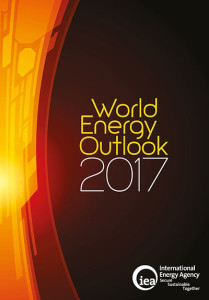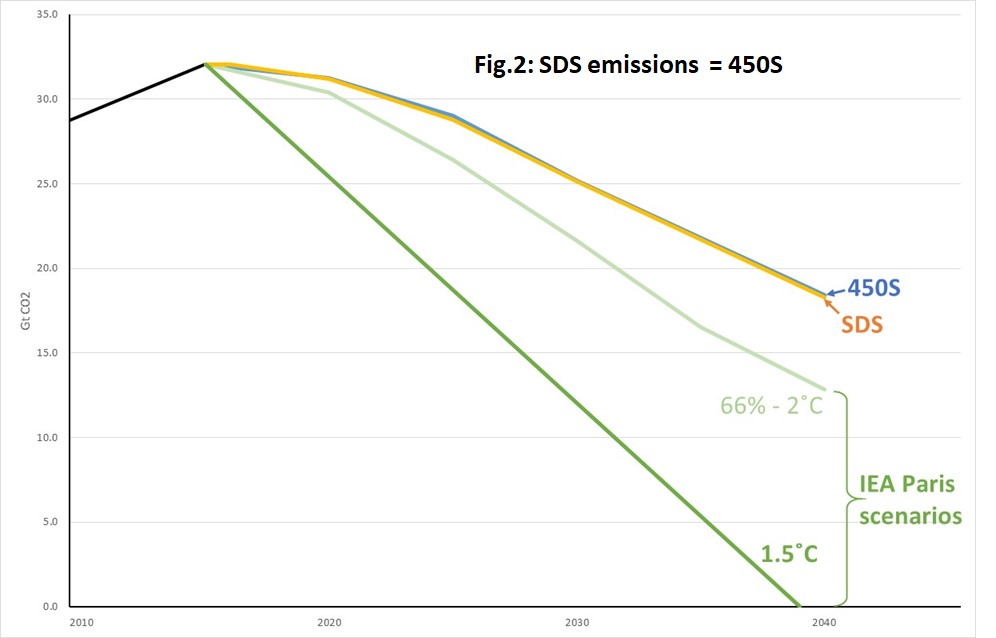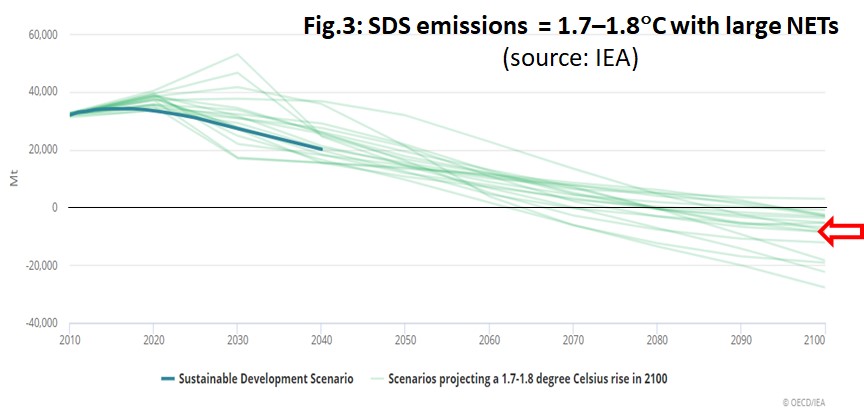
Every November, the International Energy Agency (IEA) publishes its flagship World Energy Outlook (WEO), painting a picture of the future of energy supply and demand until 2040. While focusing on business-as-usual, the WEO also includes a “Sustainable Development Scenario” (SDS), which is intended to show a pathway to achieving the energy-related Sustainable Development Goals.
Oil Change International is calling on the IEA to align the SDS with the goals of the Paris Agreement too, including 1.5 degrees Celsius (1.5°C). After all, unless policy-makers and investors are shown how to achieve the Paris goals, it will be hard for them to steer the energy system in the right direction.
The IEA says that the SDS is already aligned with the Paris goals, but in this blog, I’ll show how it falls short. And I’ll show how easy it would be for the IEA to correct the problem. In fact, two years ago, the IEA very nearly did…
The 450 Scenario (450S)
Let’s start by giving credit where it’s due. When it first published its “450 Scenario” (450S) in 2008, the IEA was ahead of the curve. That scenario – designed to give a 50% chance of keeping warming to 2°C above pre-industrial levels – reflected the goals of the more progressive governments at the time. The IEA was the first official organisation to show how to achieve that goal in practice. The 2°C goal was formalised at the Cancún climate summit two years later.

However, climate science has since indicated that even 2°C should be considered dangerous, and this recognition was incorporated into the greater ambition of the Paris goals: to hold warming to well below 2°C and to pursue efforts to limit it to 1.5°C.
The latest IPCC report this month reminds us how important this distinction is, as illustrated in this infographic (right) produced by WRI to summarise the IPCC report’s findings.
The 2016 edition of the WEO – the first to be published after the Paris Agreement – acknowledged that the 450S was not aligned with the Paris goals:
The 450 Scenario of the World Energy Outlook has for many years assessed what is needed from the energy sector up to 2040 if the world is to comply with the target of limiting the rise in the global mean temperature to below 2°C – the target in the Cancun Agreement in 2010. As outlined, the Paris Agreement in 2015 adopted new language for the global temperature target: the target is now to limit the rise in the global mean temperature to “well below 2°C” and to pursue efforts to limit warming to 1.5°C.
To begin to address this shortfall, the 2016 WEO briefly sketched two new, more ambitious scenarios, one “well below” 2°C (with a 66 percent probability of keeping warming below 2°C) and the other 1.5°C. Between them these two scenarios would reflect the range of the Paris goals.
Four months later in March 2017, the IEA then fully elaborated the 66%-2°C scenario in a standalone report commissioned by the German government. We in OCI welcomed the report (though we had some reservations about the details). Like many other WEO readers and users, we hoped that future editions of the WEO would then reflect the Paris goals in their climate scenarios.
The Sustainable Development Scenario (SDS)
In November 2017, the subsequent WEO introduced the new Sustainable Development Scenario (SDS) to replace the 450S, broadening its remit to also achieve global goals on energy access and air pollution, as well as climate.
But unfortunately, the IEA didn’t take the opportunity to upgrade its climate ambition in line with the Paris goals. The SDS has precisely the same level of CO2 emissions as the 450S, rather than the lower levels in the 66%-2°C or 1.5°C scenarios, as shown in Fig.2. In other words, the IEA has not changed its climate ambition scenario since 2008, in spite of scientific and political progress since then.

While WEO 2016 had indicated a path forward to increasing climate ambition in line with the Paris goals, at some point in 2017 the IEA switched course as it developed the SDS. The addition of the goals energy access and air pollution was a welcome one; the IEA could have done so with Paris-aligned ambition, but did not do so. WEO 2017 again only briefly sketched the 66%-2°C scenario (now renamed the Faster Transition Scenario). And this time, the 1.5°C scenario was not even mentioned.
Although it has the same emissions as the non-Paris-aligned 450S, the IEA argues that the SDS is consistent with the Paris goals.
How can the same emissions lead to a different result in 450S and SDS? The answer is that the IEA has changed its assumption about what happens after 2040, beyond the scope of its own scenarios. This is because warming over the century will be determined by emissions over the century, not just what happens until 2040. In fact, WEO 2017 suggests the SDS is consistent with the whole range of the Paris goals, including 1.5°C, depending what happens after 2040:
If CO2 emissions decline steadily to net-zero by 2100, this would be in line with holding global warming to 2 °C… To be in line with staying below 1.5 °C, emissions could fall to zero by 2060 and then become very significantly net-negative, reaching about -19 Gt by 2100.
The IEA has since suggested that the SDS sets the world on course for 1.7 to 1.8°C, by comparing it with scenarios that deliver that outcome, as shown in Fig.3. Again, as can be seen, this assumes large-scale use of “negative emissions” technologies (NETs). The IEA itself has warned of the risks of such assumptions.

Negative emissions
Since about ten years ago, many climate models have relied on an assumption that NETs will be available later in the century to suck excess carbon dioxide back out of the atmosphere. These technologies work very well in the models – they suit the models’ cost-optimising logic – but have never been tried in practice.
There is increasing concern in the scientific community over models’ major reliance on NETs. The recent IPCC report stated, “Carbon cycle and climate system understanding is still limited about the effectiveness of net negative emissions to reduce temperatures after they peak,” adding that carbon dioxide removal “deployed at scale is unproven and reliance on such technology is a major risk in the ability to limit warming to 1.5°C.”
This concern appears to be shared by the IEA. In WEO 2016, the IEA warned of the dangers:
This would imply relying, at scale, on yet unproven technology. It would also exacerbate the likelihood of adverse physical impacts arising from climate change (which generally occur in a non-linear fashion at progressively higher temperature rises).
WEO 2016 also expressed doubts about the feasibility of large-scale deployment of NETs:
Such a situation is vastly removed from the realities of the current energy system, and the prospect is remote from today’s perspective.
To achieve 8 Gt of net-negative CO2 emissions… around 3.0 million square kilometres (km2) of arable land would be required. This land area is broadly equivalent to the size of India. There are also critical questions surrounding whether or not bioenergy can be considered a CO2-neutral fuel.
The latter point referred to the fact that bioenergy grown on the wrong soils, or replacing existing biomass, or using the wrong inputs (such as fertiliser and machinery) can emit more CO2 than it absorbs. Thus to have an effective large-scale NETs system based on bioenergy and CCS (the most common technology in the models) would require massive monitoring and regulation both of bioenergy growing and of CCS storage, in order to ensure emissions were actually negative. How this could be governed internationally, with what incentives, funding and penalties, is one of the largest uncertainties in the NETs assumptions. To give an idea of scale, scientists have estimated that it would require a CO2 pipeline system about seven times the size of today’s global fossil gas infrastructure.
For these reasons, until 2016 the IEA took a welcome precautionary approach in its climate scenarios:
The 450 Scenario and the “well-below 2°C” case… offer no possibility to delay CO2 emissions reduction until negative-emissions technologies are available at scale. Nevertheless, the scenarios offer the possibility for achieving more stringent climate targets in the future, should negative-emissions technologies become available at scale.
There is no indication that the IEA changed its view on the viability of NETs during 2017. The subsequent WEO warned that “all such technologies face severe technical, economic and resource constraints”. And in its Tracking Clean Energy Progress report in June 2018, the IEA observed that the world is “far off track” from achieving progress in carbon capture and storage (CCS), which is a vital stepping stone towards NETs.
Nonetheless, the IEA’s claim that the SDS is aligned with the Paris goals cannot be true unless assuming large-scale deployment of a technology whose “prospect is remote.”
The ambition problem
At an IEA event earlier this year, an OCI colleague asked Executive Director Fatih Birol why the SDS hadn’t adopted the Paris goals into the SDS. Dr Birol confirmed (1:06:10) that the SDS climate targets are “fully in line” with the 450S, whereas meeting the Paris goals “would require a huge, exceptional transformation of our energy system in a very short period of time.”
The IEA wrote in its March 2017 standalone report that “Limiting the global mean temperature rise to below 2°C with a probability of 66% would require an energy transition of exceptional scope, depth and speed.” As for 1.5°C, the 2016 WEO stated “The changes to the energy system implied by such constrained CO2 budgets are stark… [they] can barely be imagined from today’s perspective.”
The implication of these statements is that perhaps the IEA regards the Paris goals as just too difficult (aside from the remote prospect of NETs). But looking at it the other way round, the IEA could be accused of only publishing pathways that are too easy. The potential value of climate scenarios is that they serve as a guide, showing a way that energy decisions can be made to plan for climate success. But the 450S and SDS are not being effective in that role if they don’t encourage decisions to be made differently.
All five of the oil majors state that according to the 450S or SDS they do not need to change course and will not face stranded assets. For example, BP says:
Even in the IEA 450 scenario, by 2035, the level of oil and gas is pretty much around the same level as today. Which, if you think about the very sharp decline rates, means you have to keep on investing.
According to Total:
Under the IEA’s 2°C scenario, [oil and gas] will still comprise more than 40 percent of the primary energy mix in 2035. So we must not embrace the unrealistic idea of an abrupt transition.
Even when it comes to coal, companies such as BHP Billiton and Glencore have said that they can continue with business-as-usual under the 450S or SDS. The UK government used the 450S to justify its support for arctic drilling for oil.
With the IEA’s climate scenarios used to justify continuation of the status quo rather than a change in course, clearly there is room to increase their ambition. Governments, companies and investors need to adjust their decisions to reduce emissions if the world is to achieve the Paris goals without making a risky bet on NETs. The IEA could show the way.
The IEA has the solution
The answer to all this is very easy. The IEA itself proposed it in the 2016 WEO: reduce emissions in its climate scenario to match the Paris goals. The IEA was right to add the SDGs on energy access and air pollution to create the SDS, but now it needs to adapt the SDS so that its greenhouse gas emissions are in line with Paris.
The simplest route, as proposed by the IEA, is to give two climate scenarios to reflect the range of the goals: one scenario with a 66% probability of keeping warming below 2°C, and one aiming for 1.5°C (with 50%). The message to decision-makers would then be: aim as close as you can to (“pursue efforts” towards) what is described in the 1.5°C scenario; at all costs, keep well below the 2°C scenario. That is what the Paris goals say.
The IEA should also revert to its precautionary approach to NETs: to avoid relying on them in its climate scenarios until it is proven that they can deliver at large scale. Instead, it should show ways to deliver the goals even if they do not become available.
On 13 November the IEA will publish the 2018 edition of the WEO. We will see whether the SDS ambition has been increased (with lower emissions), and/or what prominence are given to the Faster Transition / Well Below 2°C Scenario and 1.5°C Scenario.
In summary, the way to change the SDS is essentially what the IEA itself proposed two years ago. By doing so, the IEA has the opportunity for an outsized impact in helping the world towards the Paris goals, by shaping how we see our energy future and providing the tools for success.
